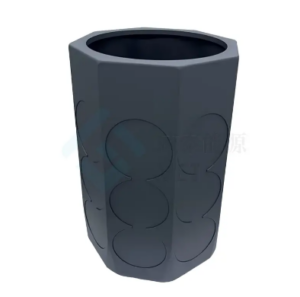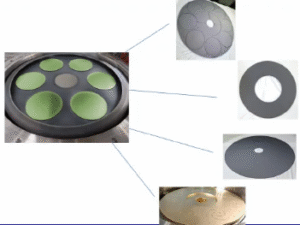SiCコーティングを正しく適用することは耐久性を保障し、性能を高めます。 摩耗、熱、化学的損傷から表面を保護し、要求の厳しい環境に不可欠です。 化学蒸気蒸着(CVD)のような技術は均一、固体層を形作ることによって精密で、良質結果を提供します。 しかし、徹底的な準備、慎重な適用、適切な治癒、および一貫した維持に依存します。 各ステップは、持続する完璧な仕上げを達成するために重要な役割を果たします。 これらの技術を習得することで、SiCコーティングのメリットを最大限に活用し、プロジェクトに最適な結果を得ることができます.
要点
- 適切な表面処理は重要です。SiCコーティングの強い付着を確実にするために、表面をきれいにし、汚染します.
- 特に要求する環境の精密で、良質SiCのコーティングのための化学蒸気の沈殿物(CVD)を利用して下さい.
- コーティングを凝固させ、耐久性を高めるために推奨硬化時間と条件に従ってください.
- 摩耗のための穏やかなクリーニングおよび点検を含む規則的な維持は、SiCのコーティングの寿命を拡張します.
- 最良の慣行やメーカーのガイドラインに従うことによって、不均等なアプリケーションや不適切な治癒などの一般的な間違いを避けてください.
- 温度や化学的暴露などの要因を考慮し、プロジェクト固有のニーズに基づいて適切なSiCコーティングを選択します.
SiCコーティングの理解
SiCコーティングとは?
SiCのコーティング、または炭化ケイ素のコーティングはさまざまな表面の耐久性そして性能を高めるように設計されている保護層です。 これらのコーティングは、その例外的な特性のために際立っています。これは、要求の厳しいアプリケーションに適しています.
SiCコーティングの特性
SiCコーティングは驚くべき耐久性を提供します。 摩耗および摩耗に抵抗し、摩耗を防ぎ、過渡材料のための長続きがする保護を保障します。 熱抵抗は高温環境でよく実行し、航空宇宙や製造などの業界に理想的です。 また、耐薬品性に優れたコーティングです。 腐食性物質から遮蔽された表面で、過酷な化学設定での信頼性を保証します.
SiCのコーティングを使用して共通の適用および企業
幅広い業界にSiCコーティングが採用されています。 半導体業界では、極端な温度や化学暴露から部品を保護しています。 製造業では、摩耗を減らすことによって用具および機械類の寿命を高めます。 航空宇宙用途は、高熱と摩擦に耐えるためにこれらのコーティングに依存しています。 エネルギー分野においても、SiCコーティングは、困難な条件にさらされた機器の効率性と耐久性を向上させます.
SiCコーティングの利点
SiCコーティングは、多くの用途に価値のある選択肢を得られる多くの利点を提供します。 これらの利点を理解することで、特定のニーズを満たすことができます.
表面保護および長寿の強化
SiCコーティングは、表面を損傷から保護する堅牢なバリアを作成します。 この保護は頻繁に取り替えのための必要性を減らす材料の寿命を拡張します。 工具、機械、部品を保護するかにかかわらず、これらのコーティングは長期的な信頼性を保証します.
高層環境における性能向上
高圧環境では、SiCのコーティングはExcelを包みます。 彼らは極端な熱、圧力、および化学暴露の下で、その完全性を維持します。 このレジリエンスは、コーティングされた表面の性能を高め、最も要求の厳しい条件でも効率的に機能することができます.
「SiCコーティングの用途は、さまざまな産業用途に適した材料の耐摩耗性と酸化性を効果的に改善することができます。」 – 業界インサイト
SiCコーティングのユニークな特性と利点を活用することで、プロジェクトの優れた結果を得ることができます.
準備ステップ
適切な準備はSiCのコーティングの適用の成功を保障します。 これらの手順に従って、コーティングが効果的に付着することを可能にするきれいで、滑らかおよび保護された表面を作成できます.
表面のクリーニングおよび汚染
汚れ・グリース・汚れの除去の重要性.
コーティングと基質の間に強い結束を達成するためにきれいな表面が不可欠です。 土、グリースおよび他の汚染物質は障壁として機能し、コーティングを付着からきちんと防いで下さい。 これらの不純物は不均等な適用、弱点、または時間上の皮をむくことができます。 表面の洗浄は、これらのリスクを徹底的に排除し、耐久性と完璧な仕上げのための基盤を設定します.
推奨洗浄剤およびツール.
産業表面のために特に設計されているクリーニングの代理店を使用して下さい。 アセトンやイソプロピルアルコールなどの溶剤は、グリースや油を除去するのによく働きます。 汚れや残骸のために、水と混合される穏やかな洗剤は有効です。 糸なしの布、ソフトブラシ、スポンジなどの道具で、表面を傷つけないようにします。 頑固な汚染物質のために、材料に応じて、圧力洗濯機または超音波洗剤を使用して検討して下さい.
表面修正
表面欠陥を識別し、対処します(例えば、亀裂、不均等性).
亀裂、歯、または不均等な領域のような欠陥のために表面を注意深く点検して下さい。 これらの欠陥は、弱点やギャップを作成することで、コーティングのパフォーマンスを妥協することができます。 これらの問題に対処すると、スムーズで均一なアプリケーションが確保されます。 これらの領域はしばしば隠れた欠陥を持っているので、エッジやコーナーに細心の注意を払ってください.
基質を磨くか磨くための技術.
砂および磨くことは表面の欠陥を修正するための有効な方法です。 粗い部分を滑らかにするか、またはマイナーな傷を取除くために適切な屑サイズが付いているサンドペーパーを使用して下さい。 より深い欠陥のために、粗い屑から始め、次第に磨かれた終わりのためのより細かい屑に動かして下さい。 回転式緩衝のような磨く用具は、ミラー様の表面を達成するのを助けることができます。 砂を取るか、または磨くことの後で再度表面を塵および残骸取除きますきれいにして下さい.
マスキングと保護
コーティングされていない領域を保護する方法.
表面のすべての部分がコーティングを必要とするかもしれません。 アプリケーションプロセスを開始する前にそれらをマスクすることにより、これらの領域を保護します。 このステップは偶然のコーティングを防ぎ、きちんとした、専門の結果を保障します。 ジョイント、ファスナー、または可動部などのセクションを識別し、非コーティングを維持する必要があります.
効果的なマスキングのためのツールと材料.
しっかり密着した高品質のマスキングテープを使用して、残留物を残さずにきれいに取り除きます。 大きい区域のために、プラスチック シートかアルミ ホイルを使用して考慮して下さい。 実用的なナイフやはさみのような精密ツールは、特定の形状に合わせてマスキング材料をカットするのに役立ちます。 マスキングテープのエッジをしっかり押下し、コーティングが下面の汚れを防止します.
これらの準備手順を完了することにより、SiCコーティングを適用するための理想的な表面を作成します。 コーティングが適切に付着し、効果的に実行し、長く持続するように細部へのこの注意.
応用プロセス
SiCコーティングを適用するための技術
化学蒸気蒸着(CVD)とその利点の概要
化学蒸気蒸着(CVD)はSiCコーティングを加えるための最も有効な方法の1つです。 この技術は、炭化ケイ素の固体、均一な層を反応し、形成する蒸発させた化学先駆者に表面を露出することを含みます。 CVDはコーティングの厚さおよび構成の精密な制御を保障しま、高性能を要求する適用のためにそれを理想的にします。 それはまた腐食および摩耗への抵抗を高める最低の不純物のコーティングを作り出します。 特に産業や高強度の環境のために、耐久性と一貫性のある仕上げを達成するために、CVDに依存することができます.
他の方法(例えば、スプレー、ブラシをかけること)およびそれらの特定の使用
CVDは非常に効果的ですが、スプレーやブラシなどの他の方法は、さまざまなアプリケーションのための柔軟性を提供します。 スプレーすることで、大きな表面を素早く均一に塗ることができます。 スピードやカバレッジが優先するプロジェクトに適しています。 一方、ブラシをかけることは小さいですか複雑な区域のためのより大きい制御を提供します。 この方法は、タッチアップや精密が必要な場合に適しています。 各技術にはユニークな利点がありますので、プロジェクトの要件と使用中のSiCコーティング材料の種類と合わせるものを選択する必要があります.
工具・材料 必須
エッセンシャルツール(例えば、スプレーガン、ブラシ、アプリケーター)
SiCコーティングを効果的に適用するには、適切なツールが必要です。 スプレーガンは、大きな表面に塗布しても必要です。 ブラシは細部かより小さい区域のために最もよく働きます。 ローラーなどのアプリケーターは、特定のプロジェクトにも役立ちます。 開始する前に、ツールがきれいで良好な状態にあることを確認してください。 適切なツールは、コーティングの品質を向上させるだけでなく、アプリケーションプロセスをより効率的にします.
SiCコーティング材料とその特定の用途の種類
SiCのコーティング材料は液体の解決、粉および蒸発させた前駆体を含むさまざまな形態で、入って来ます。 液体の解決は多目的で、スプレーかブラシをかけることの技術とよく働きます。 粉は熱噴霧のような専門にされた適用で、頻繁に使用されます。 蒸化前駆体は、CVDプロセス専用です。 各マテリアルタイプには特定のプロパティと利点があります。そのため、プロジェクトのニーズに合ったものを選択する必要があります。 例えば、液質溶液は汎用用途に理想的で、蒸化前駆体は高精度コーティングに優れています.
ステップバイステップアプリケーションガイド
コーティング材料の準備(例えば、混合、粘度調整)
SiCコーティングを適用する前に、メーカーの指示に従って材料を準備します。 液液液液溶液を使用している場合は、均一性を確保するために徹底的に混ぜます。 必要に応じて粘度を調整します。, これは、コーティングが表面に付着する方法に影響を及ぼすので、. 粘度カップまたは同様のツールを使用して、目的の一貫性を測定し、達成します。 適切な準備はコーティングが期待どおりに実行し、均等に付着することを保障します.
コーティングを均等に適用する技術
SiCコーティングを均等に適用するには、小さな領域でツールをテストすることによって開始します。 スプレーのために、表面から一貫した間隔を維持し、スプレーガンを滑らかに動かして下さい、打撃を重くして下さい。 不均一なビルドアップを防ぐため、一点でリンダリングを避けてください。 ブラシをかけるとき、安定した、打撃を使用し、薄い層を加えて下さい。 各レイヤーが別のレイヤーを追加する前に乾燥できるようにします。 これらの技術は、均一な仕上げを達成し、コーティングの有効性を最大化するのに役立ちます.
Safety Precautions
個人的な保護装置(PPE)のの重要性
適切な個人的な保護装置(PPE)を身につけることはSiCのコーティング プロセスの間にあなたの安全を保障します。 SiCコーティングは、不適切に処理した場合、あなたの健康にリスクを課すことができる化学物質や材料を含みます。 有害物質への暴露を最小限に抑え、事故を防止します.
安全ゴーグルを着用して、スプラッシュやエアボーンの粒子から目を保護します。 耐薬品性手袋を使用して、コーティング材料との直接接触から手を保護します。 長袖のラボコートやカバールは、こぼれやドリップから肌を保護します。 呼吸保護のために、特に蒸発させた前駆体またはスプレーと働いたとき、特に化学煙のために評価されるマスクかマスクを身に着けて下さい。 PPEが適切にフィットし、業界の安全基準を満たしていることを確認してください.
「適切なPPEの使用は、怪我を防止し、安全な作業環境を確保することが重要である」 – 労働安全ガイドライン
PPEを優先することにより、より安全なワークスペースを作成し、有害物質への暴露の危険性を低減します.
換気とワークスペースの安全のヒント
SiCコーティングを適用する際に、適切な換気が不可欠です。 CVDやスプレーなどの多くのコーティングプロセス、あなたの呼吸器系に害を与えることができるリリース煙。 十分に換気された区域で働くことは新しい空気循環を保障し、有害な蒸気の集中を減らします.
排気ファンやフードが装備されているエリアでワークスペースを設定します。 これらのツールは、毒性の煙を除去し、空気の品質を維持するのに役立ちます。 屋内で作業する場合、窓とドアを開けて気流を改善します。 煙が蓄積できる限られたスペースを避けてください。 屋外の適用のために、不均等なコーティングか汚染を防ぐために強い風から離れた場所を選んで下さい.
事故を回避するために、ワークスペースを整理しておく。 危険性を未然に防ぐため、所定の場所にある工具や材料を保管してください。 安全な環境を維持するためにすぐにこぼれをきれいにしてください。 スプレーガンや硬化装置などの電気機器は、故障を避けるために良好な状態にあることを確認します.
これらの安全対策に従うことで、SiCコーティングアプリケーションを成功させるための安全なワークスペースを守ります.
硬化・メンテナンス
Curing the Coating
硬化方法(例、空気乾燥、熱硬化)
SiCコーティングを硬化させ、耐久性を確保します。 コーティング材料および適用条件によって空気乾燥および熱治癒の間で、選ぶことができます。 空気乾燥は室温で治るコーティングのためによく働きます。 この方法は最小限の装置を要求し、より小さいプロジェクトか非産業設定のために適しています。 一方、熱硬化は、コーティングされた表面を露出することによってプロセスを加速し、熱を制御します。 コーティングの付着力および性能を、特に産業適用のために高めます。 硬化オーブンまたはヒートランプを使用して、プロセス中に一貫した温度を維持します.
最適な結果のための推奨硬化時間と条件
時代や条件を治すためのメーカーのガイドラインに従ってください。 ほとんどのSiCコーティングは特定の持続期間および温度を要求しま最適結果を達成します。 空気乾燥のために、コーティングはきれいで、ほこりのない環境で24〜48時間硬化させることを可能にします。 熱硬化は200°間の温度を要求します Fと400° コーティングの処方に応じて、1〜3時間F。 硬化プロセスを密接に監視し、過熱や過熱を避けるため、コーティングの有効性を妥協することができます。 適切な治癒はコーティングが完全な保護潜在的な達成を保障します.
コーティングを維持する
コーティングを保存するためのクリーニングとケアのヒント
定期的な清掃は、SiCコーティングの完全性を維持するのに役立ちます。 汚れや破片を取除くのに穏やかな石鹸および水が付いている柔らかい布かスポンジを使用して下さい。 研磨剤の洗剤や表面を傷つける道具を避けてください。 頑固な汚れのために、上塗を施してある表面のために推薦される非腐食性のクリーニングの代理店を使用して下さい。 表面を徹底的に洗い流し、水場を防止します。 ルーチン洗浄は、コーティングの外観と性能を維持し、根本的な材料を保護し続けることを保証します.
摩耗の印およびコーティングを再適用するとき
変色、皮をむく、または薄くなることのような摩耗の印のための規則的にコーティングを点検して下さい。 これらの問題はコーティングがもはや十分な保護を提供することができないことを示します。 高強度環境や過酷な条件への頻繁な曝露は摩耗を加速できます。 これらの兆候に気づくと、コーティングを再適用して効果を回復させます。 適切な維持および時機を得た適用はコーティングの寿命を拡張し、一貫した性能を保障します.
一般的な間違いとヒント
アプリケーションエラーを回避する
共通の間違い(例えば、不均等な適用、不適切な治癒)
SiCコーティングプロセス中の間違いは、仕上げの品質と耐久性を妥協することができます。 不均等なアプリケーションは、最も頻繁なエラーの1つです。 コーティングが厚すぎる部分や薄く塗られた場合などに発生します。 それは弱点、皮をむく、または矛盾する出現に導きます。 不適切な治癒は別の一般的な問題です。 硬化プロセスを傷つけるか、または推奨条件に従うことに失敗すると、脆性または過度のコーティングが発生する可能性があります.
これらの問題を避けるために、常にアプリケーションと硬化のためのメーカーの指示に従ってください。 各層の厚さに注意を払い、カバレッジさえ保障して下さい。 スプレーガンやブラシなどの適切なツールを使用して、一貫性を維持します。 治癒のために、温度を監視し、指定された要件を満たすために時間を密接に時間を計って下さい.
プロセス中に問題のトラブルシューティングと修正方法
不均等な適用に気付いたら、コーティングが治る前にすぐに機能して下さい。 ぬれたコーティングのために、表面を滑らかにするのにきれいなブラシかアプリケーターを使用して下さい。 コーティングがすでに乾燥している場合は、不均等な領域を穏やかに砂をし、問題を修正するために薄層を再び適用してください。 不適切な治癒のために、損傷を評価する。 コーティングがブリルまたは不完全な場合、それを完全に取除き、適切な治癒条件で始めて下さい.
トラブルシューティングの際には、ツールやワークスペースを調べてください。 汚れや破損したツールは、アプリケーションエラーを引き起こす可能性があります。 これらがコーティングの付着を妨げることができるので、ワークスペースがほこりや破片の自由であることを確認してください。 これらの要因に対処することで、再発の問題を防ぎ、より良い結果を得ることができます.
成功のためのエキスパートのヒント
スムーズで耐久性のある仕上げを実現するベストプラクティス
完璧な仕上げを達成するために、準備はキーです。 SiCコーティングを塗る前に表面を十分にきれいにし、滑らかにして下さい。 選択したアプリケーション方法に合った高品質のツールを使用してください。 スプレーのために、表面からの一貫した間隔を維持し、薄い、層を適用して下さい。 各レイヤーが次のレイヤーを追加する前に十分に乾燥できるようにします。 耐久性を高め、欠陥を防ぎます.
汚染を最小限にするために制御された環境で働きます。 塵、湿気および温度の変動はコーティングの性能に影響を与えることができます。 適切な換気を使用して、安全を確保し、アプリケーションプロセスに最適な条件を維持します。 定期的に進行状況を調べて、問題の早期発見と修正を行います.
特定のニーズに適したSiCコーティングを選択するためのアドバイス
適切なSiCコーティングを選択すると、プロジェクトの要件によって異なります。 運用環境、基材、所望の性質などの要因を考慮してください。 高温用途では、耐熱性に優れたコーティングを選択します。 化学薬品の露出のために、強い化学抵抗のコーティングを優先します。 精度が重要な場合は、化学蒸気蒸着(CVD)のような方法を選択して均一で高品質の仕上げを実現します.
お客様の用途に合わせて、メーカーの仕様をコンサルティングします。 適合性および性能を保障するために完全な適用の前に小さい区域をテストして下さい。 適切なSiCコーティングを選択することにより、その利点を最大限に高め、長持ちする保護を確保することができます.
SiCコーティングを効果的に適用することは準備、適用、治癒および維持の4つの重要なステップに注意を払います。 各ステップは、コーティングが適切に付着し、意図どおりに実行することを確認します。 化学蒸気蒸着(CVD)のような技術は精密で耐久性のある結果を提供し、高品質の仕上がりに好まれる選択をします。 輪郭をとったプロセスに従って、滑らかで長持ちするコーティングを達成できます。 常に安全を優先し、適切なツールを使用して、成功を確実にするためにきれいなワークスペースを維持します。 これらの実践により、SiCコーティングのメリットを最大限に高めることができます.






